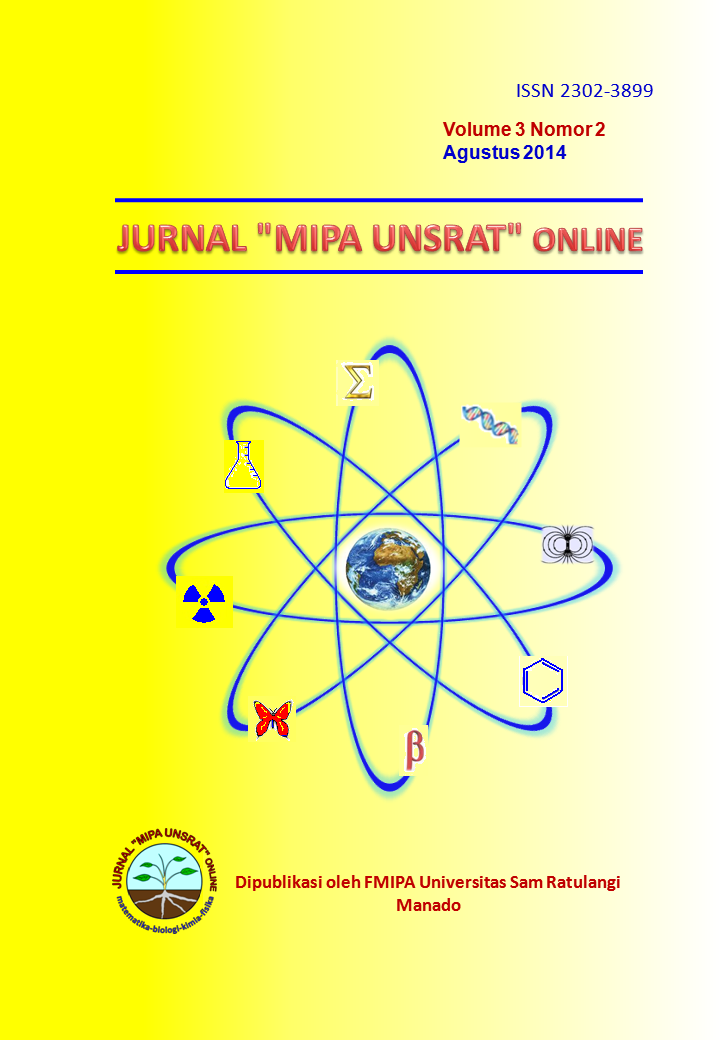Barcode DNA Tumbuhan Pangi (Pangium edule R.) Berdasarkan Gen matK
DOI:
https://doi.org/10.35799/jm.3.2.2014.5862Abstract
DNA barcoding merupakan suatu teknik yang digunakan untuk mempercepat dan mempermudah proses identifikasi organisme dengan menggunakan potongan gen tertentu. Penelitian ini bertujuan untuk menentukan sekuens DNA barcode tumbuhan pangi berdasarkan gen standar matK dan membandingkannya dengan spesies yang berkerabat dekat di GenBank. DNA total daun pangi diisolasi menggunakan Innuprep plant DNA kit dan berhasil diamplifikasi dengan proses Polymerase Chain Reaction (PCR) menggunakan primer berdasarkan gen matK. Hasil sekuensing fragmen DNA yang menunjukkan panjang 720 bp yang teramplifikasi oleh primer forward dan 780 bp untuk yang teramplifikasi oleh primer reverse. Hasil analisis BLASTn menunjukkan tingkat kemiripan tumbuhan pangi sangat tinggi dengan Trichadenia zeylanical, yaitu 99%, dan diikuti spesies lainnya (Kiggelaria africanal, 98%; Guthriea capensis, 96%; Acharia tragodes, 92%; Erythrospermum phytolaccoides, 92%; Hydnocarpus sp. Chase 1301, 90%; Carpotroche longifolia, 89%; Moultonianthus leembruggianus, 89% dan Pimelodendron zoanthogyne, 88%). Analisis komposisi asam amino menunjukkan bahwa matK Pangium edule dan kesembilan spesies tumbuhan lainnya bersifat hidrofobik.
DNA barcoding is a technical used to accelerate and simplify the process identification of organism with by using a snipping of specific genes. This study aimed to determine the DNA sequences of plant barcoding standard pangi based gene matK and compare with closely related species in GenBank. Total DNA was isolated using Innuprep pangi leaf plant DNA kit and successfully amplified by the Polymerase Chain Reaction (PCR) using primers based on the gene matK. The results of sequencing long DNA fragments showed7 20 bp are amplified by the forward primer and 780 bp were amplified by the primer for reverse. Blast analysis of the results showed very extremely high the plant pangi degree of similarity with Trichadenia zeylanical, namely99%, and followed by other species (Kiggelaria africanal, 98%; Guthriea capensis, 96%; Acharia tragodes, 92%; Erythrospermum phytolaccoides, 92%; Hydnocarpus sp. Chase 1301, 90%; Carpotroche longifolia, 89%; Moultonianthus leembruggianus, 89% dan Pimelodendron zoanthogyne, 88%). Analysis of aminoacid composition showed that matK Pangium edule and nine other plant species are hydrophobic.






